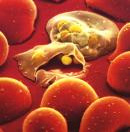Lyases are one of the major classifications of enzymes. These enzymes are responsible for breaking double bonds through the addition of water, ammonia, or carbon dioxide. Lyases can also form double bonds by the removal of these products from the substrate. Lyases are found in both prokaryotic and eukaryotic organisms, and in an equally diverse range of biological pathways. This page will focus on three different examples: Fructose-1,6-bisphosphate aldolase, isolated from the malaria parasite Plasmodium falciparum; Pectate lyase, isolated from Bacillus subtilis; and rat type II adenylyl cyclase C2 domain. All three of these structures have been determined by X-ray crystallography and will be discussed in further detail.


